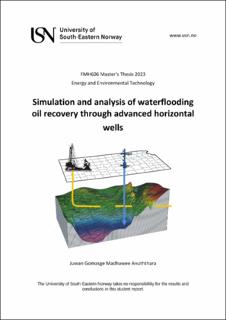Simulation and analysis of waterflooding oil recovery through advanced horizontal wells
Master thesis
Permanent lenke
https://hdl.handle.net/11250/3081321Utgivelsesdato
2023Metadata
Vis full innførselSamlinger
Sammendrag
The oil industry has been a significant source of energy for many years, but over 50% of oil in existing fields in NCS cannot be produced by using current enhanced and improved oil recovery technologies. Various IOR methods have been tested in the world to improve the efficiency of oil recovery methods. Long horizontal wells are commonly used in industry to maximize the oil production, but they can lead to early gas or water breakthroughs due to the water conning effect. To overcome this issue, different inflow control devices such as ICDs, AICVs, and AICDs are used in oil well completion. This thesis aims to study the performance of advanced well technologies for oil production from reservoirs with different oil viscosities using a unique approach of coupling the ECLIPSE simulator for reservoir simulation and the OLGA simulator for oil well simulation. Simulations for oil production with advanced well completions were conducted for a heavy and light oil reservoir using two vertical and one horizontal water injection wells, respectively, as the IOR method. Before the water breakthrough, AICDs and AICVs were fully open and acted like ICDs. After the breakthrough, AICD and AICV closed partially due to increasing WC. FCDs delayed the water breakthrough by 10 and 180 days for heavy and light oil reservoirs, respectively. Moreover, the cumulative oil production has increased slightly, and the cumulative water production has decreased considerably in both cases because of FCDs. Therefore, oil well completion with FCDs can potentially increase the efficiency of oil production by maximizing profit and by minimizing unwanted fluids production. Furthermore, it can be concluded that coupling the ECLIPSE/OLGA simulators has been successful at the end of the thesis.
